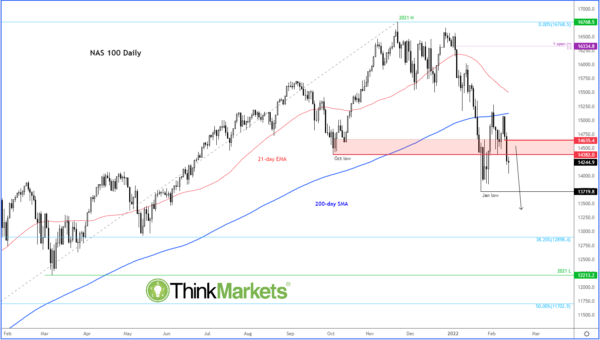It might be Valentine’s Day, but government bonds are unlikely to find much love any time soon.
The key themes that have dominated market sentiment remains the same: inflation, central bank policy tightening and the Ukrainian situation. Sentiment remains cagey as fundamentally nothing has changed. We might see government bonds stage short-covering bounces here and there, but ultimately, they remain in a bear trend as traders front-run the Fed in anticipating policy tightening. Therefore, bond yields are likely to remain in an uptrend, which, at best, should limit the potential gains for over-valued technology stocks. For the same reason, the US dollar should continue to perform well against currencies where the central banks comparatively less hawkish.
Russia: We support diplomatic talks
In what has been a relatively quiet day for economic data, the start of the new trading week has been as one would have expected following last week’s selling into the close. European stocks and US futures fell noticeably this morning, although by around mid-day in London they managed to bounce back equally sharply. This was in response to comments from Russia’s foreign minister Sergey Lavrov. Mr Lavrov was addressing the press alongside President Vladmir Putin, and said he supports continuing diplomatic talks with the West in response to a question on whether “there was a chance for agreement” on key issues. He said he can see a way to move forward with talks. This eased investor nerves over an “imminent” invasion of Ukraine by Russia, something which Kremlin has continually denied.
Inflation: Elephant in the room
Beyond Russia and Ukraine, it is all about how central banks are going to address surging inflationary pressures around the world, not least the Federal Reserve. One particular Fed official who has been making headlines was at it again. St. Louis Fed President James Bullard repeated his call for 100 bps in hikes by 1st July. Bullard argues that the Fed needs to push interest rates up quickly because “our credibility is on the line here.”
We will have more inflation pointers to look forward to this week, in the form of headline and core producer price indices on Tuesday. PPI is expected to have risen by an additional 0.5% month-over-month in January, while core PPI is seen climbing 0.4% m/m. In addition, the FOMC’s minutes from its January meeting will be published on Wednesday, which could reveal more hawkish signals from policymakers.
How high will yields go?
So, the key question is what will happen to yields, which will, of course, have repercussions for other financial markets, not least US tech stocks. It is possible that if we see a stronger-than-expected PPI print that this will lead to further strength for yields. At around 2.0%, the 10-year yield is way lower than the 7.5% inflation rate. This means that real yields are actually -5.5%. This is bizarre, to say the least. The Fed’s QE programmes and strong foreign demand for US debt are the main reasons for this mis-match. The question is, why aren’t yields higher? Is it because the market is expecting nominal inflation rates to fall back, and quickly? Perhaps. Even if inflation falls back to around 3%, real yields would still be negative. Therefore, it is reasonable to expect yields to catch up with inflation. I reckon we will be heading towards 3.00% on the 10-year in the coming weeks, the speed of which will depend on incoming data and whether more Fed officials will turn as hawkish as Bullard. This should keep tech stocks under pressure, but support financials.














